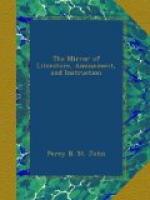The portico of the Bowery Theatre is immeasurably the finest morceau of architecture in the city. It resembles that of Covent-Garden, but seems to be nobler and greater; and yet I am not sure if, in point of dimensions, it is larger, or so large as that of Covent-Garden. The only objection to it—and my objection is stronger against the London theatre—is the unfitness. In both cases, the style and order are of the gravest Templar character, more appropriate to the tribunals of criminal justice, than to the haunts of Cytherea and the Muses.—New Monthly Mag.
* * * * *
THE TRUE FORNARINA.
The account of a journey which was taken in the year 1664, by Cosmo, the son of Ferdinand II. de Medici, was written at the time, by Philip Pizzichi, his travelling chaplain. This work was published for the first time at Florence, about seven months ago. It contains some curious notices of persons and things, and among them, what will interest every lover of the fine arts. It is this—speaking of Verona, he mentions the Curtoni gallery of paintings, and says, “The picture most worthy of attention is the lady of Raffaello, so carefully finished by himself, and so well preserved that it surpasses every other.” The editor of these travels has satisfactorily shown that Raffaelo’s lady here described is the true Fornarina; so that of the three likenesses of her said to be executed by this eminent artist, the genuine one is the Veronese, belonging to the Curtoni gallery, now in the possession of a lady Cavellini Brenzoni, who obtained it by inheritance.—Monthly Magazine.
* * * * *
ITALIAN SCENERY.
Happy is the man, who, leaving the Alps behind him, has the plains of Lombardy on his right hand and on his left, the Apennines in view, and Florence as the city towards which he directs his steps. His way is through a country where corn grows under groves of fruit trees, whose tops are woven into green arcades by thickly-clustering garlands of vines; the dark masses of foliage and verdure which every where appear, melt insensibly, as he advances, into a succession of shady bowers that invite him to their depths; the scenery is monotonous, and yet ever various from the richness of its sylvan beauty, possessing all the softness of forest glades without their gloom. Towards Bologna, the landscape roughens into hills, which grow into Apennines, but Arcadia still breathes from slopes and lawns of tender green, which take their rise in the low stream-watered valleys, and extend up the steep ascent till met midway by the lofty chestnut groves which pale them in. To these gentler features succeeds the passage of the Apennines, which here, at least, are not as the author of “Italy as it Is,” describes them, “the children of the Alps—smiling and gentle and happy




